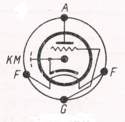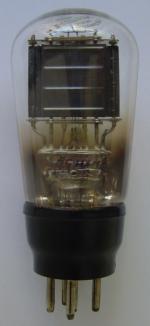
AC/HL
|
|
|||||||||||||||||||||||||||||||||||||||||||||||
|
Hits: 15881 Replies: 6
AC/HL
|
|
|
Peter den Boer † 2025
01.Mar.11 |
1
I have an early Mazda AC/HL with strange 5 pin base. The two short pins are the filament pins. The three long pins are for the anode, grid and cathode. But which pin is connected to what?
|
|
Konrad Birkner † 12.08.2014
01.Mar.11 |
2
I think it is not a Mazda but a Metropolitan-Vickers (Cosmos) valve. The base shows clearly the logo. How to find out base connections: Prereqisite: continuity at the filament pins. I would start with a capacity measurement from one filament end against the three long pins, one after the other. The one showing the highest value is the cathode. Do not expect much difference: the f-k value may be only 3-4 pF higher than at f-g, Now jumper the other two pins and connect a milliammeter from these pins (-!) to the cathode (+!). OK? Good luck! |
|
Wolfgang Holtmann
01.Mar.11 |
3
Dear Peter Sure you have an old fashion ohmmeter at hand. The one at the negative lead of the meter indicates the cathode. The positive lead must be connected to the grid. The third pin left is, of course, the anode. Best regards |
|
Alan Scott Douglas † 16.11.15
01.Mar.11 |
4
Judging by the illustrations in Keith Thrower's book on 1926-1946 valves, the anode is the one marked "A" on the base, the next pin clockwise is the cathode, and the third is the grid. It was after all made to plug into a standard valve socket. |
|
Peter den Boer † 2025
03.Mar.11 |
5
Yes there is a Metropolitan-Vickers logo on the base. But on top of the bulb is printed Mazda and AC/HL. The AC/HL is a 4 Volt indirect heated triode. The AC/HL base does not fit into a B4/B5 base, but there were adapters available. The pinout is shown below. The anode pin is indicated with an A on the base. Thanks for the info. |
|
Konrad Birkner † 12.08.2014
03.Mar.11 |
6
Well, Metrovick activities went together with Mazda in the late 1920's. That is ok, no contradiction. But the tube does fit in the B4 socket. Only a special (flat) contact adapter must have been provided to supply the indirect heater (short pins)
I think that was another attempt to convert battery radios for wall plug operation. Regards, |
|
Peter den Boer † 2025
03.Mar.11 |
7
Konrad, Yes it fits in as you has drown. When the anode pin is put into the anode connection, it fits. I tried the two F and the G connection, but that does nor work. Regards, Peter |
End of forum contributions about this tube
| Data Compliance | More Information |








 .
.